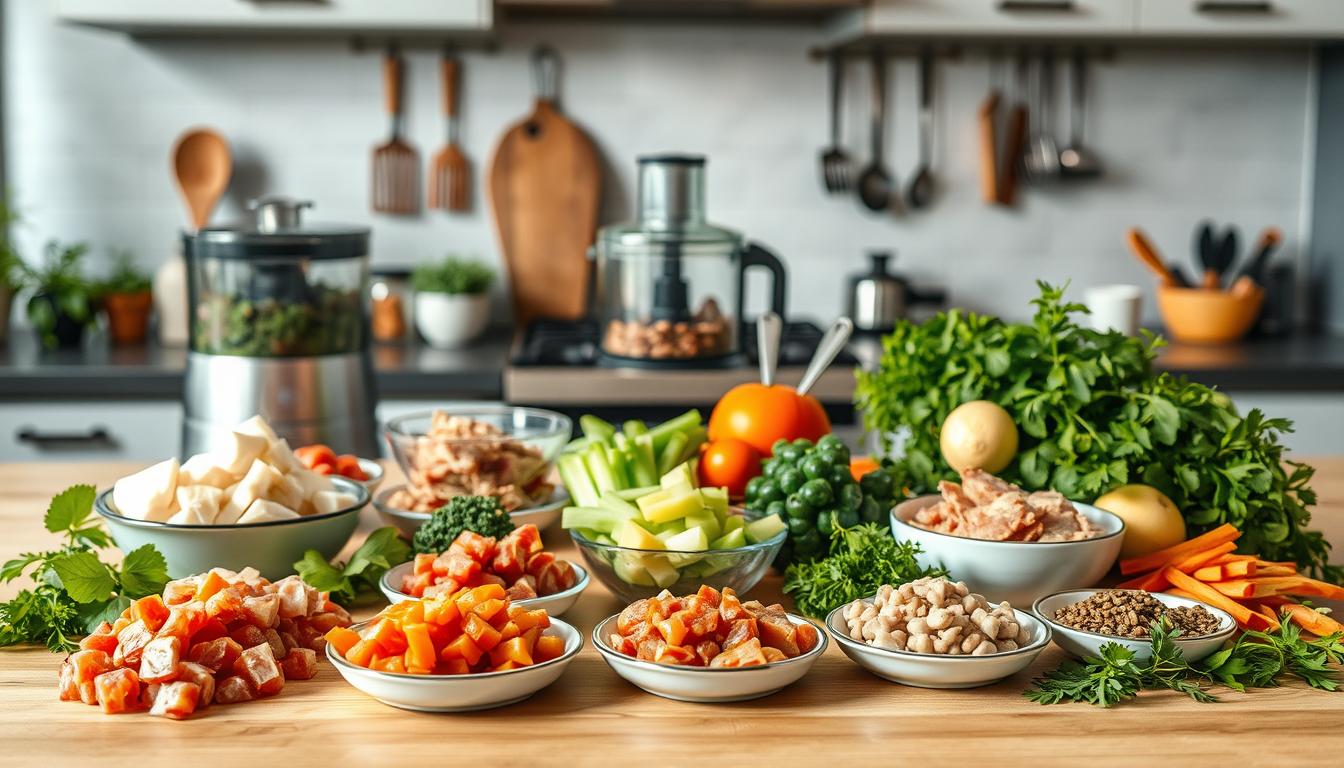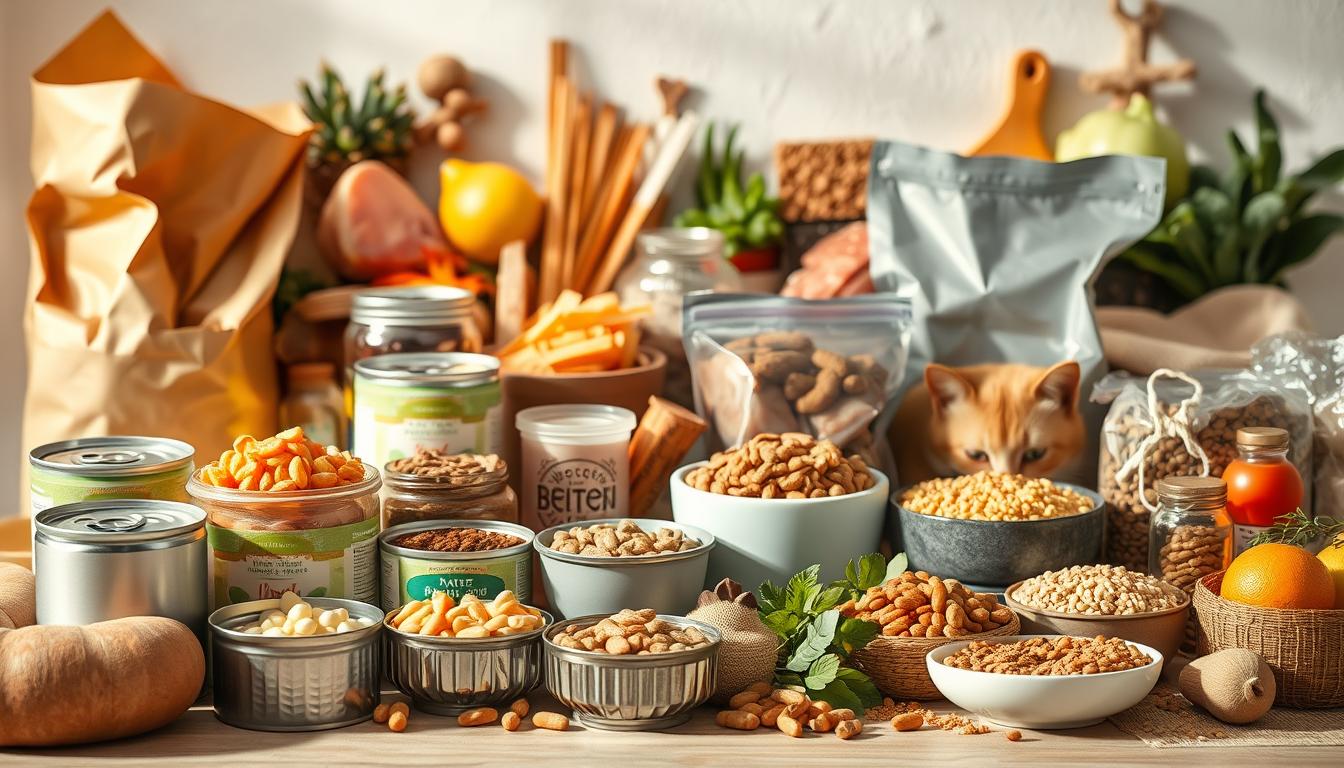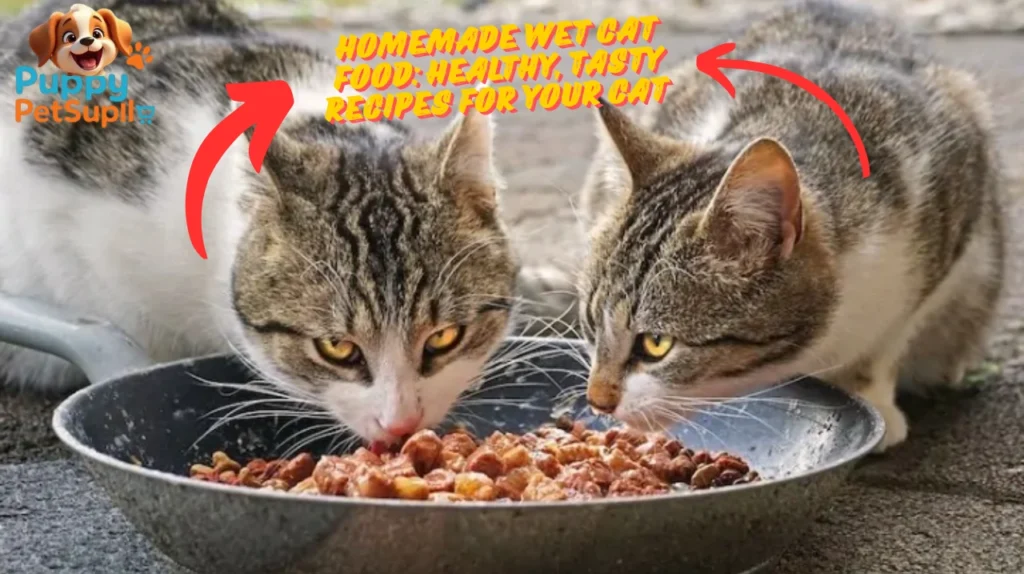Homemade Wet Cat Food: Healthy, Tasty Recipes for Your Cat
Many commercial cat foods have fillers and by-products that harm a cat’s health. Making healthy homemade cat food lets owners pick the ingredients. This ensures their pets get the nutrients they need.

Homemade wet cat food recipes
By making diy cat food, owners can make meals fit their cat’s needs. This boosts their health and happiness. It also makes the bond between pet and owner stronger.
Key Takeaways
- Preparing homemade meals for your cat allows for control over ingredients.
- Healthy homemade cat food can enhance your cat’s overall health.
- Diy cat food recipes can be tailored to your cat’s specific nutritional needs.
- Making homemade cat food can strengthen the bond between you and your pet.
- Homemade wet cat food recipes offer a healthier alternative to commercial products.
Why Make Your Own Wet Cat Food?
Making your own wet cat food at home is easy and effective. It ensures your cat gets the nutrients they need. Many commercial cat foods have fillers and mystery ingredients that harm your cat’s health. By making your own, you can avoid these and tailor the recipes to your cat’s needs.
Health Benefits for Your Feline Friend
Homemade wet cat food has many health benefits. Experts say it can improve your cat’s health, making them live longer and feel better. “A diet rich in essential nutrients and free from harmful additives can significantly enhance your cat’s quality of life,” a renowned veterinarian notes. By controlling the ingredients, you ensure your cat gets the nutrients they need without the risks of commercial cat foods.
Cost Comparison: Homemade vs. Commercial
One big advantage of homemade wet cat food is the cost savings. For example, homemade cat food can cost as little as $47.45 a year. This is compared to $104.03 for commercial brands like Fancy Feast. Making your own cat food saves money and provides a healthier diet. This makes homemade cat food a great choice for many cat owners.

Benefits of homemade cat food
Essential Nutrients Your Cat Needs
Knowing what your cat needs to eat is key for their health. Cats are meat-eaters and need a lot of protein from animal sources. A good diet for your cat should have all the nutrients they need to stay healthy.
Protein Requirements for Cats
Cats need a lot of protein in their food. Protein from animal sources helps keep their muscles strong and their body working right. It’s best if protein is the main part of their diet.
Necessary Vitamins and Minerals
Cats also need certain vitamins and minerals to be healthy. They need vitamins A, D, and E, and minerals like calcium and phosphorus. Making sure their food has these nutrients is very important.
The Importance of Taurine
Taurine is an essential amino acid found in animal-based proteins. It’s important for a cat’s heart and eyes. Without enough taurine, cats can get very sick, so it’s a must-have in homemade cat food.

Cat nutrition
- High-quality protein from animal sources
- Vitamins A, D, and E
- Minerals such as calcium and phosphorus
- Taurine for heart health
Kitchen Equipment and Preparation Basics
To make healthy homemade cat food, you’ll need the right tools and follow sanitation guidelines. Preparing your cat’s meals at home is rewarding. It ensures your pet gets the nutrients they need without additives found in commercial products.
Essential Tools for Making Cat Food
You’ll need a grinder or food processor to mix ingredients. Measuring cups and spoons are also necessary for accurate ingredient amounts. Plus, stainless steel bowls and utensils are best for easy cleaning and sanitizing.
| Equipment | Purpose |
| Grinder/Food Processor | Blending ingredients |
| Measuring Cups/Spoons | Accurate ingredient proportions |
| Stainless Steel Bowls/Utensils | Easy cleaning and sanitizing |
Sanitation and Food Safety
Keeping a clean environment is key when making homemade cat food. Always wash your hands before starting. Make sure all equipment is sanitized, like sterilizing utensils and bowls in boiling water or using a dishwasher.
Proper handling and storage of raw ingredients are also important. They help prevent bacterial contamination.
Homemade Wet Cat Food Recipes Your Cat Will Love
Making homemade wet cat food is a great way to keep your cat healthy. It lets you use fresh ingredients and recipes that your cat will enjoy. This way, you can make sure your cat gets the nutrients they need.
Simple Chicken Recipe
This recipe is perfect for beginners. It’s easy to make and uses common ingredients.
Ingredients List
- 1 pound boneless, skinless chicken breast or thighs
- 1/4 cup finely chopped carrots
- 1/4 cup cooked brown rice
- 1 tablespoon fish oil
- 1 teaspoon flaxseed oil
Step-by-Step Preparation
First, grind the chicken in a food processor until it’s finely chopped. Then, add the chopped carrots, cooked brown rice, fish oil, and flaxseed oil. Mix well until everything is fully incorporated. Put the mixture in an airtight container and refrigerate or freeze as needed.
Tuna and Rice Formula
This recipe is packed with protein and omega-3 fatty acids. It’s a great choice for your cat’s meals.
Ingredients List
- 1 can of tuna in water (drained and flaked)
- 1/2 cup cooked white rice
- 1/4 cup finely chopped green beans
- 1 tablespoon salmon oil
Step-by-Step Preparation
Mix the flaked tuna with cooked white rice, chopped green beans, and salmon oil in a bowl. Stir well until everything is fully incorporated. Serve right away or store in an airtight container in the fridge for later.
Beef and Pumpkin Blend
This recipe is great for cats who need more fiber. The pumpkin adds nutrition, while the beef provides protein.
Ingredients List
- 1 pound ground beef
- 1/2 cup cooked pumpkin
- 1/4 cup finely chopped sweet potatoes
- 1 tablespoon coconut oil
Step-by-Step Preparation
Cook the ground beef in a pan until it’s fully browned, breaking it up as it cooks. Add the cooked pumpkin, chopped sweet potatoes, and coconut oil. Mix well and simmer for a few minutes. Let it cool before serving to your cat.
Specialized Homemade Wet Cat Food Recipes for Health Concerns
Cats with health issues can benefit from homemade wet cat food. This food is made to meet their specific needs. It can help with sensitive stomachs, weight management, or the needs of senior cats.
Recipes for Sensitive Stomachs
Cats with sensitive stomachs need food that’s easy on their digestive system. A good choice is the Gentle Turkey and Rice Recipe.
Gentle Turkey and Rice Recipe
This recipe is easy to digest and gives your cat the nutrients they need.
- 1 pound of ground turkey
- 1/2 cup of cooked white rice
- 1/4 cup of finely chopped green beans
- 1 teaspoon of fish oil
Mix all ingredients and serve. This recipe is easy to prepare and gentle on your cat’s stomach.
Weight Management Formulas
Keeping your cat at a healthy weight is important for their health. Homemade cat food for weight management should be low in calories but high in protein. This keeps your cat full and satisfied.
- Use lean proteins like chicken or turkey
- Incorporate vegetables like green beans or carrots
- Avoid fillers and high-calorie ingredients
Senior Cat Nutrition Blend
Senior cats have different nutritional needs than younger cats. They need more joint support and ingredients that are easy to digest.
- Include joint supplements like glucosamine
- Use easily digestible protein sources
- Add fiber for digestive health
By tailoring your cat’s diet to their health concerns, you can improve their quality of life. Always talk to your vet before changing your cat’s diet.
Proper Storage and Serving of Homemade Cat Food
Storing and serving homemade cat food right is key. You want to keep it fresh and full of nutrients for your cat. This ensures they get the best from their meals.
Freezing and Thawing Guidelines
Freezing is a great way to keep homemade cat food fresh. Put the food in airtight containers or freezer bags. Make sure to remove air before sealing.
Label the containers with the date and what’s inside. To thaw, use the fridge or cold water. Never thaw at room temperature or in the microwave, as bacteria can grow.
Portion Control and Feeding Schedule
Having a regular feeding schedule is important for your cat’s health. Figure out how much food your cat needs based on their age, activity, and nutritional needs. Split their daily food into 2-3 meals to keep them full and prevent overeating.
Keep an eye on your cat’s weight and adjust their food portions if needed. A good feeding plan keeps your cat healthy and ensures they get all the nutrients they need.
Transitioning Your Cat to Homemade Food
Switching to homemade cat food should be done slowly to avoid digestive problems. It’s key to introduce the new food bit by bit. This lets their digestive system get used to it.
Gradual Introduction Methods
To start, mix a little homemade food with their usual food. Slowly add more homemade food over 7-10 days. This gradual introduction helps avoid stomach upset.
Here’s a mixing plan you can follow:
| Day | Commercial Food | Homemade Food |
| 1-2 | 75% | 25% |
| 3-4 | 50% | 50% |
| 5-7 | 25% | 75% |
| 8+ | 0% | 100% |
Addressing Picky Eaters
Some cats are picky eaters, making the switch hard. To help them accept it, try warming the homemade food a bit. This makes it smell better. Or, mix in a bit of tasty liquid, like chicken broth.
Conclusion
Making cat food at home is good for your cat’s health and your wallet. Homemade wet cat food offers better nutrition and less risk of chronic diseases. It also lets you manage your cat’s diet more easily.
Creating healthy, tasty recipes for your cat is simple. You just need the right ingredients and kitchen tools. This way, you can give your cat the nutrients they need to stay healthy.
Start giving your cat a healthier, happier life today. Begin making homemade wet cat food. See how it improves your cat’s overall well-being.
FAQ
Making homemade wet cat food lets you pick the ingredients. This ensures your cat gets the nutrients they need. It also avoids fillers and mystery ingredients found in commercial cat food.
To ensure nutritional balance, include essential nutrients like protein. Also, add necessary vitamins and minerals, and taurine. Consider consulting with a veterinarian or a certified animal nutritionist.
Yes, you can create recipes tailored to your cat’s specific health needs. This includes sensitive stomachs, weight management, or senior cat nutrition. Adjust ingredients and portion sizes as needed.
Store homemade cat food in airtight containers in the refrigerator. Please keep it for up to three to five days. Or, freeze it for longer storage, following proper freezing and thawing guidelines.
Gradually introduce homemade cat food into your cat’s diet. Start by mixing it with their current food, beginning with small amounts. Increase the proportion over time to prevent digestive issues.
Common ingredients include chicken, tuna, beef, pumpkin, and rice. These provide essential nutrients and can be combined in various ways to create healthy, tasty meals.
Making homemade cat food can be cost-effective. Buying ingredients in bulk and preparing meals in advance can be more economical than purchasing commercial cat food.
Yes, you can adjust recipes based on your cat’s preferences. Use different protein sources or add ingredients like pumpkin for digestive health.
Establish a feeding schedule that meets your cat’s nutritional needs. Typically, feed them two to three times a day. Adjust portion sizes based on their individual requirements.
Yes, maintain a clean and safe environment during preparation. Handle raw ingredients safely, and sanitize equipment. This prevents bacterial contamination.

